

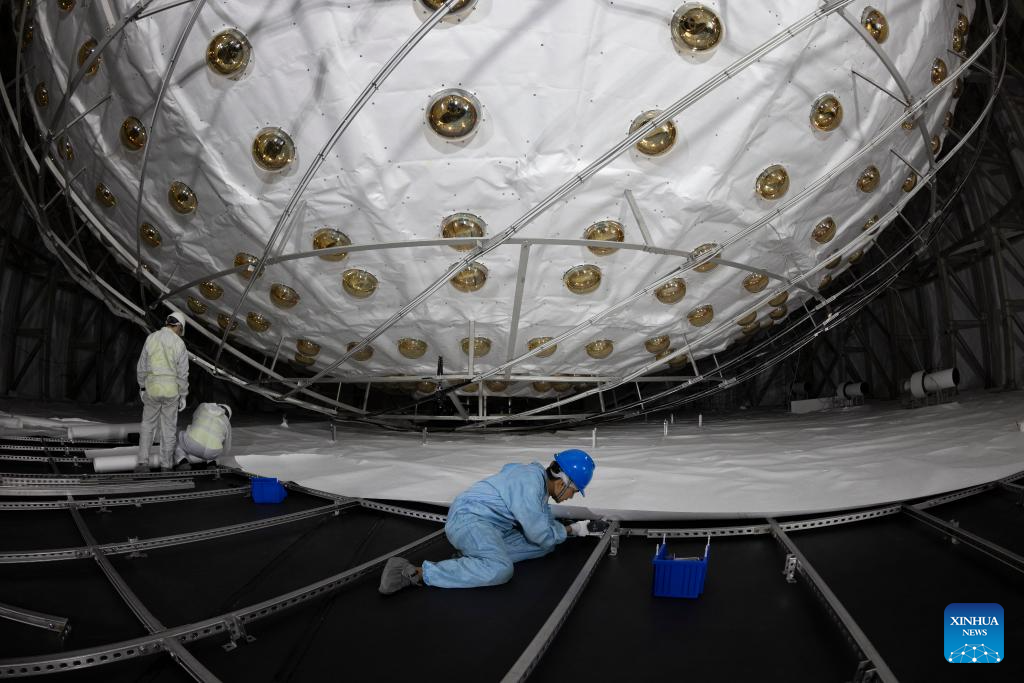
Staff members seal the bottom of a water tank with Tyvek material at the construction site of the Jiangmen Underground Neutrino Observatory (JUNO) in Jiangmen, south China's Guangdong Province, Dec. 16, 2024. The liquid filling of the central detector of JUNO started on Wednesday. As one of the world's most powerful experiments to uncover neutrino mystery, JUNO is expected to operate for at least 30 years. (Xinhua/Jin Liwang)
GUANGZHOU, Dec. 18 (Xinhua) -- The world's largest transparent spherical detector started filling with ultrapure water Wednesday, signifying that the construction of the neutrino research facility has reached its last critical stage.
The ultrapure water, which has been filtered through multiple stages of the water purification system, is injected at a flow rate of 100 tonnes per hour into the detector pool of the Jiangmen Underground Neutrino Observatory (JUNO), according to the Institute of High Energy Physics under the Chinese Academy of Sciences, the project's leading institution.
The core of JUNO is a liquid scintillator detector immersed in a 44-meter-deep cylindrical pool in the underground hall buried deep in a granite layer of a hill in Kaiping, Jiangmen City, in south China's Guangdong Province. The detector is supported by a stainless steel mesh shell with a diameter of 41.1 meters, which holds an acrylic sphere with a diameter of 35.4 meters to be filled with 20,000 tonnes of liquid scintillator.
The detector is equipped with 20,000 photomultiplier tubes of 20 inches and 25,000 photomultiplier tubes of three inches, as well as cables, magnetic shielding coils, light baffles and other components.
The pool housing the detector serves as a water Cherenkov detector and a shield, with a 1,000-square-meter cosmic ray tracker at its top. The water Cherenkov detector and the cosmic ray tracker work together to detect cosmic rays, thereby eliminating the impact of cosmic rays on neutrino detection.
The water in the pool also shields the interference of natural radioactivity from the surrounding rock and a large number of secondary particles produced by cosmic rays in nearby rocks.
The photomultiplier tubes covering the inner walls of the liquid scintillator detector will jointly detect the scintillation light produced when neutrinos are captured by the liquid scintillator, converting the light signals into electrical signals for output.
Compared to the best international level, the volume of the liquid scintillator has increased by 20 times, the photoelectron yield has increased by three times, and the energy resolution has reached an unprecedented level of 3 percent.
The liquid-filling process is divided into two steps. The pool and the space inside the acrylic sphere will be filled with ultrapure water in the first two months. After that, the water inside the acrylic sphere will be replaced with a liquid scintillator in six months.
The entire filling process is expected to be completed in August 2025, followed by the formal operation and data collection.
Neutrinos, the smallest and lightest among the 12 elementary particles that make up the material world, are electrically neutral and travel at a speed close to light. Since the Big Bang, they have permeated the entire universe and generated various phenomena, such as nuclear reactions inside stars, supernova explosions, the operation of nuclear reactors, and the radioactive decay of substances in rocks.
Since neutrinos rarely interact with ordinary matter, they can easily zip through our bodies, buildings or the entire Earth without being felt, hence earning the nickname "ghost particles." Due to their elusive nature, neutrinos are the least understood fundamental particles, requiring massive detectors to capture their faintest traces.
JUNO aims to measure the neutrino mass hierarchy as its primary scientific goal and will conduct several other cutting-edge research projects. The JUNO team comprises more than 700 members from 17 countries and regions.
JUNO is expected to become an important facility for international neutrino research, along with the Hyper-Kamiokande neutrino experiment in Japan and the Deep Underground Neutrino Experiment in the United States, which are currently under construction.

This photo taken on Dec. 16, 2024 shows the central detector of the Jiangmen Underground Neutrino Observatory (JUNO) in Jiangmen, south China's Guangdong Province.
The liquid filling of the central detector of JUNO started on Wednesday.
As one of the world's most powerful experiments to uncover neutrino mystery, JUNO is expected to operate for at least 30 years. (Xinhua/Jin Liwang)
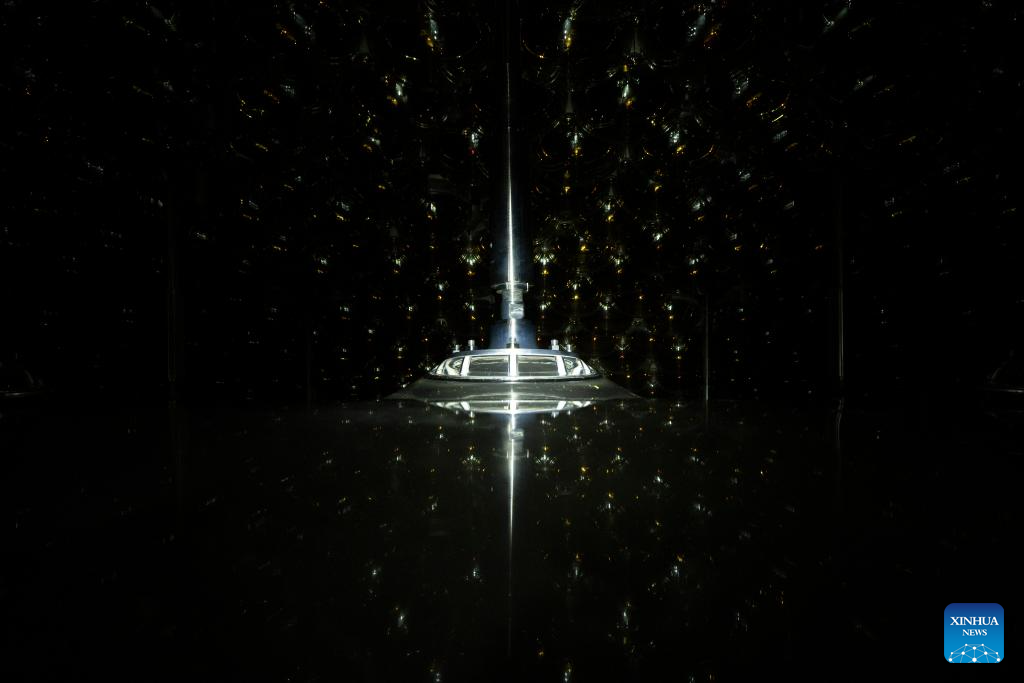
This photo taken on Dec. 17, 2024 shows photo-multiplier tubes seen from the top of the acrylic sphere of the Jiangmen Underground Neutrino Observatory (JUNO) in Jiangmen, south China's Guangdong Province.
The liquid filling of the central detector of JUNO started on Wednesday.
As one of the world's most powerful experiments to uncover neutrino mystery, JUNO is expected to operate for at least 30 years. (Xinhua/Jin Liwang)
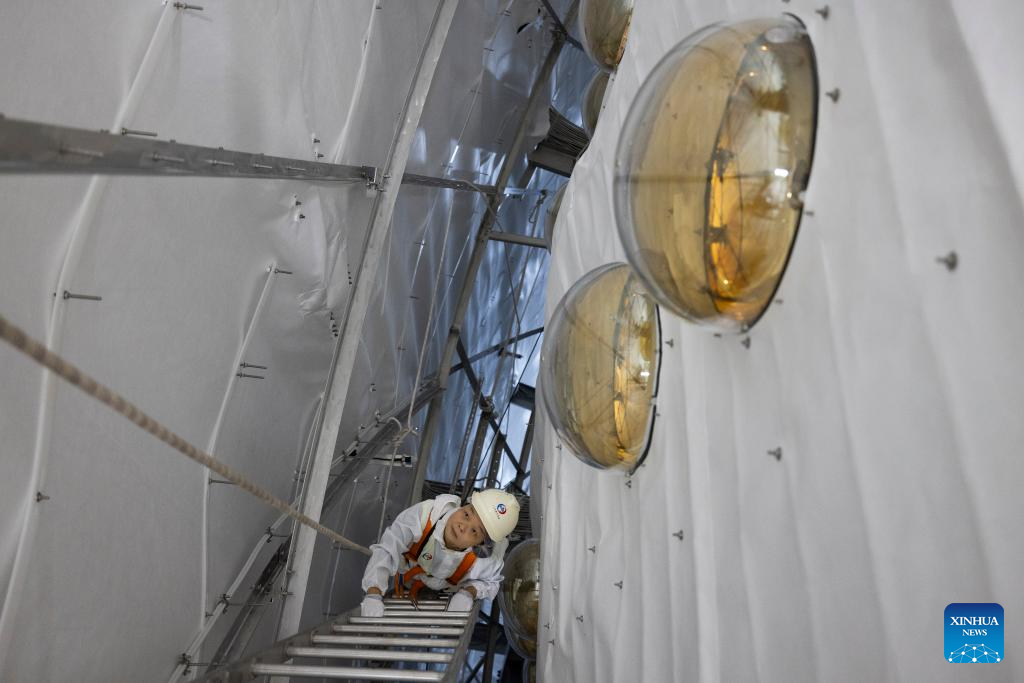
Ma Xiaoyan, chief engineer of the Jiangmen Underground Neutrino Observatory (JUNO), inspects the construction site of JUNO in Jiangmen, south China's Guangdong Province, Dec. 17, 2024.
The liquid filling of the central detector of JUNO started on Wednesday.
As one of the world's most powerful experiments to uncover neutrino mystery, JUNO is expected to operate for at least 30 years. (Xinhua/Jin Liwang)
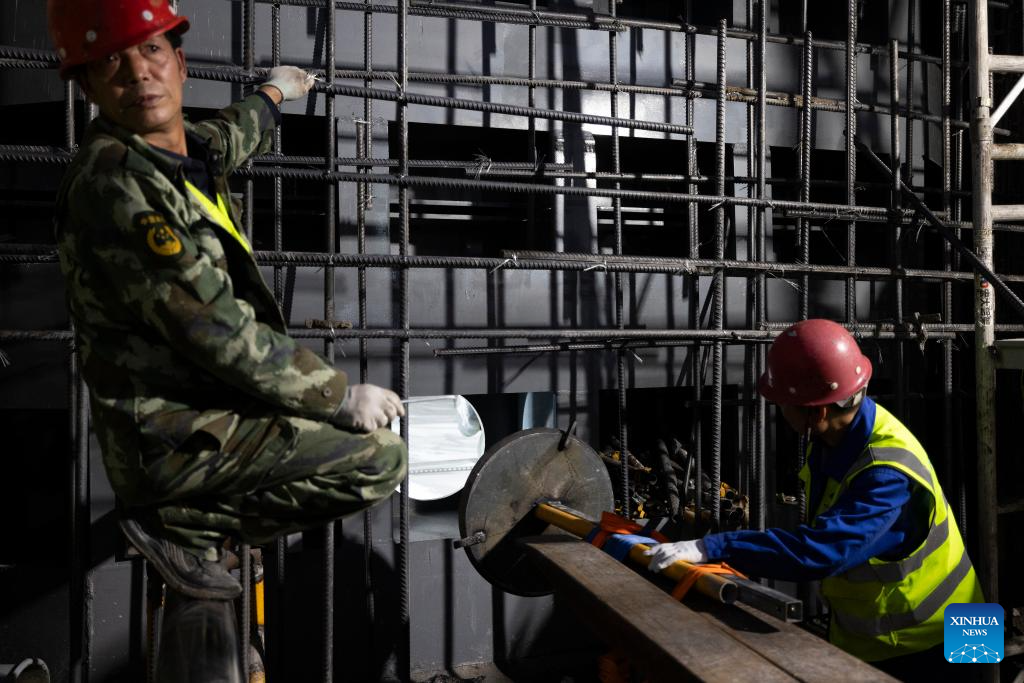
Staff members cover the last hole in the water tank of the Jiangmen Underground Neutrino Observatory (JUNO) in Jiangmen, south China's Guangdong Province, Dec. 17, 2024.
The liquid filling of the central detector of JUNO started on Wednesday.
As one of the world's most powerful experiments to uncover neutrino mystery, JUNO is expected to operate for at least 30 years. (Xinhua/Jin Liwang)
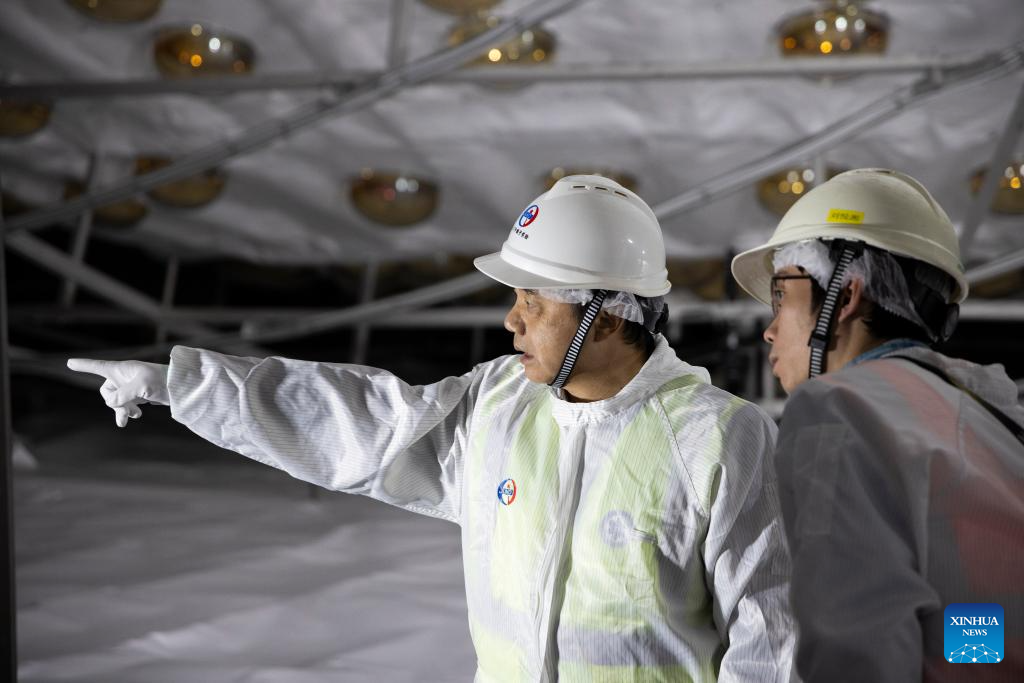
Wang Yifang (L), chief scientist of the Jiangmen Underground Neutrino Observatory (JUNO), communicates with his colleague at the construction site at the bottom of a water tank of JUNO in Jiangmen, south China's Guangdong Province, Dec. 16, 2024.
The liquid filling of the central detector of JUNO started on Wednesday.
As one of the world's most powerful experiments to uncover neutrino mystery, JUNO is expected to operate for at least 30 years. (Xinhua/Jin Liwang)
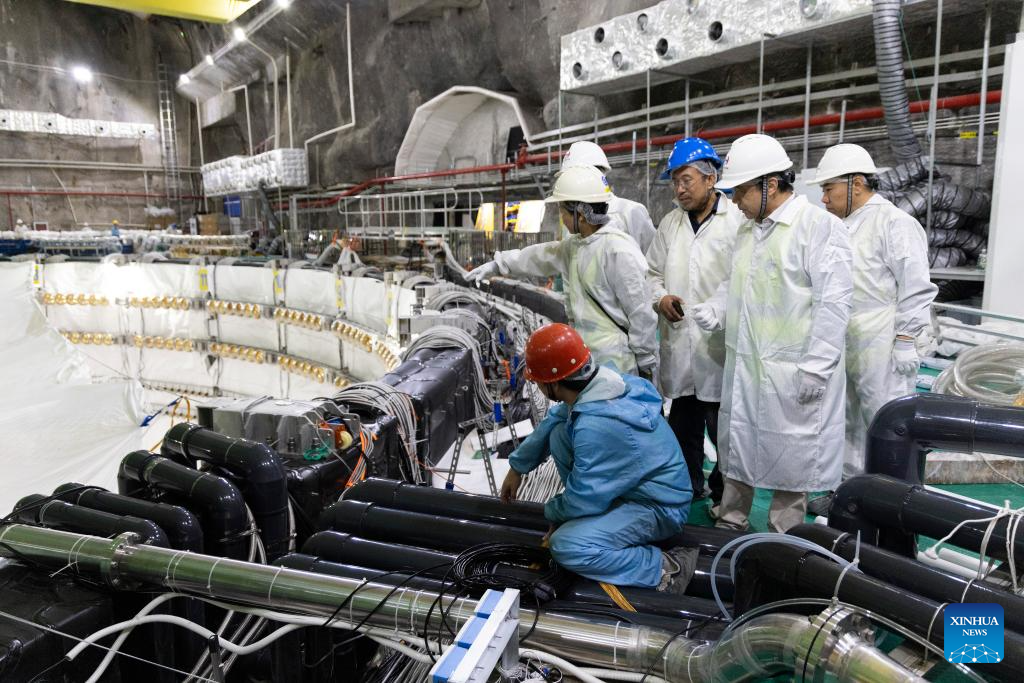
Wang Yifang (2nd R), chief scientist of the Jiangmen Underground Neutrino Observatory (JUNO), and Ma Xiaoyan (4th R), chief engineer of the JUNO, check the status of liquid filling of JUNO in Jiangmen, south China's Guangdong Province, Dec. 18, 2024.
The liquid filling of the central detector of JUNO started on Wednesday.
As one of the world's most powerful experiments to uncover neutrino mystery, JUNO is expected to operate for at least 30 years. (Xinhua/Jin Liwang)
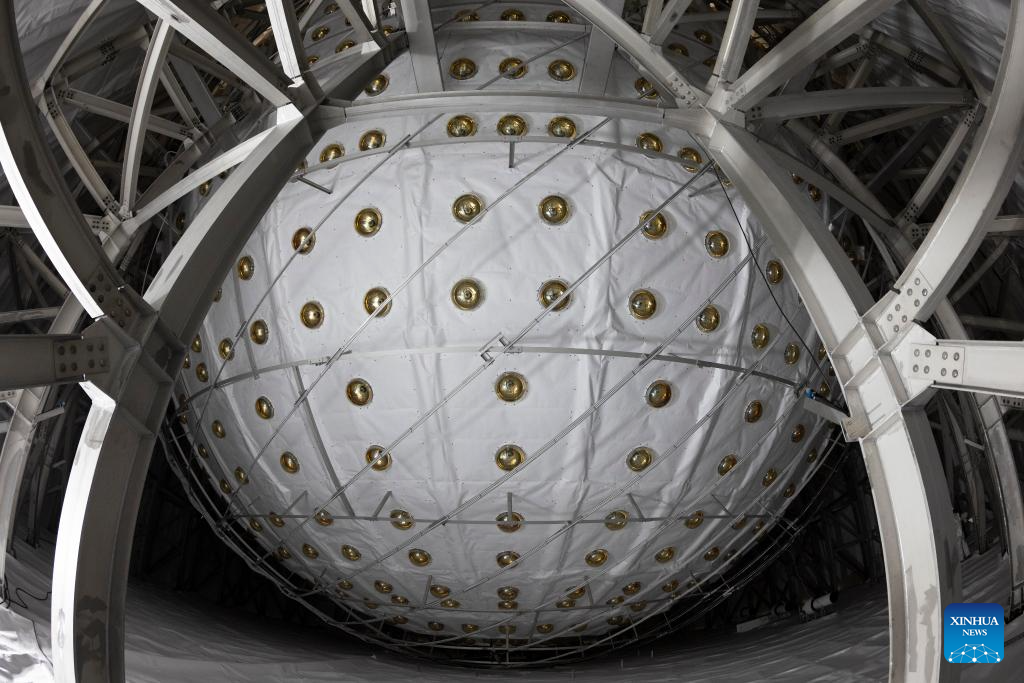
This photo taken on Dec. 17, 2024 shows the central detector of the Jiangmen Underground Neutrino Observatory (JUNO) in Jiangmen, south China's Guangdong Province.
The liquid filling of the central detector of JUNO started on Wednesday.
As one of the world's most powerful experiments to uncover neutrino mystery, JUNO is expected to operate for at least 30 years. (Xinhua/Jin Liwang)

Researchers observe the status of the water tank after the liquid filling process started at the Jiangmen Underground Neutrino Observatory (JUNO) in Jiangmen, south China's Guangdong Province, Dec. 18, 2024.
The liquid filling of the central detector of JUNO started on Wednesday.
As one of the world's most powerful experiments to uncover neutrino mystery, JUNO is expected to operate for at least 30 years. (Xinhua/Jin Liwang)
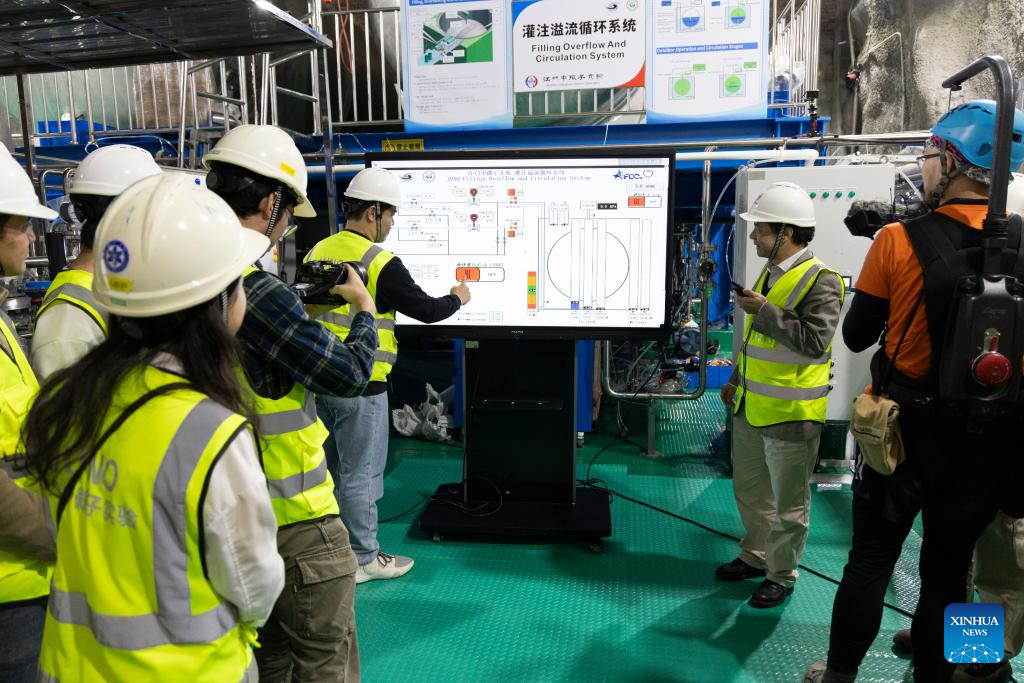
Wang Yifang (2nd R), chief scientist of the Jiangmen Underground Neutrino Observatory (JUNO), together with other researchers, starts the liquid filling of JUNO in Jiangmen, south China's Guangdong Province, Dec. 18, 2024.
The liquid filling of the central detector of JUNO started on Wednesday.
As one of the world's most powerful experiments to uncover neutrino mystery, JUNO is expected to operate for at least 30 years. (Xinhua/Jin Liwang)
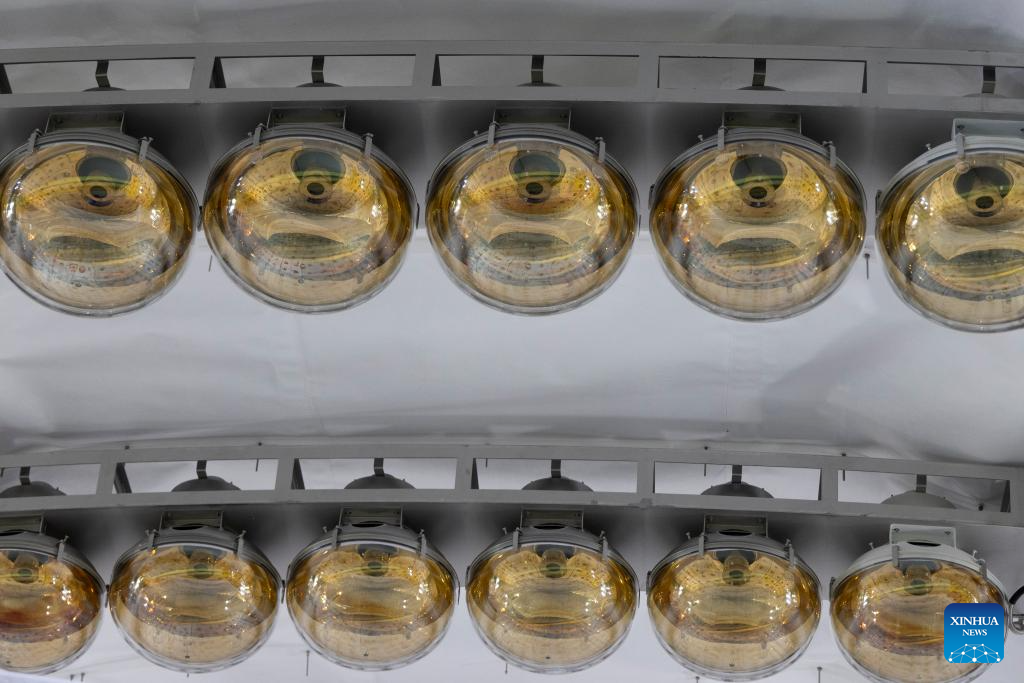
This photo taken on Dec. 17, 2024 shows photo-multiplier tubes inside the acrylic sphere of the Jiangmen Underground Neutrino Observatory (JUNO) in Jiangmen, south China's Guangdong Province.
The liquid filling of the central detector of JUNO started on Wednesday.
As one of the world's most powerful experiments to uncover neutrino mystery, JUNO is expected to operate for at least 30 years. (Xinhua/Jin Liwang)
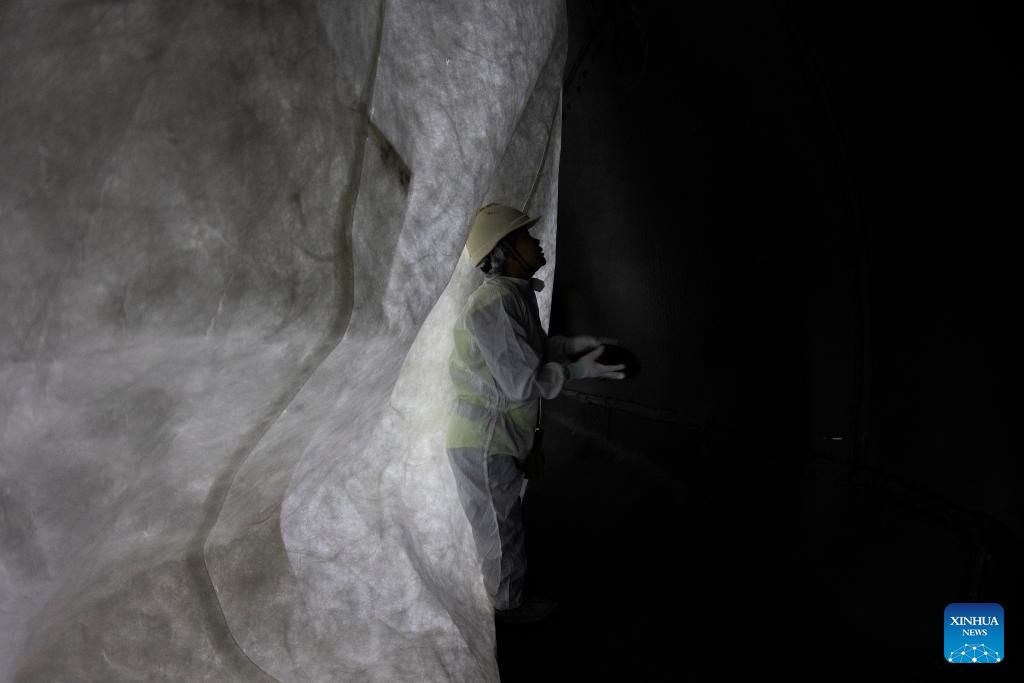
Ma Xiaoyan, chief engineer of the Jiangmen Underground Neutrino Observatory (JUNO), checks the bottom of a water tank of the JUNO in Jiangmen, south China's Guangdong Province, Dec. 16, 2024.
The liquid filling of the central detector of JUNO started on Wednesday.
As one of the world's most powerful experiments to uncover neutrino mystery, JUNO is expected to operate for at least 30 years. (Xinhua/Jin Liwang)
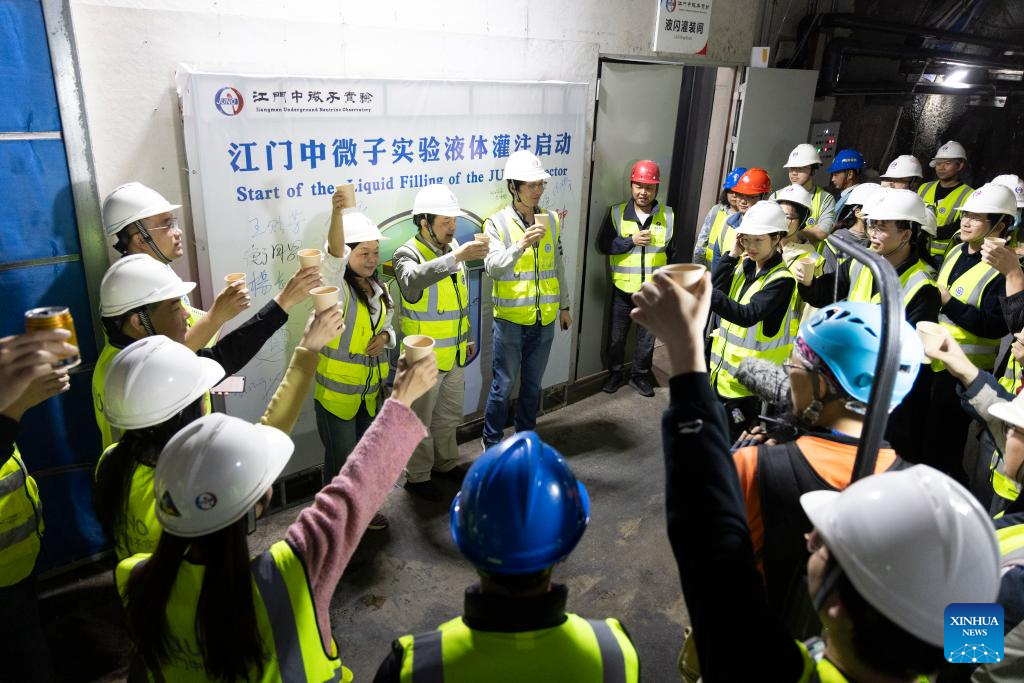
Researchers make a toast to mark the start of liquid filling at the Jiangmen Underground Neutrino Observatory (JUNO) in Jiangmen, south China's Guangdong Province, Dec. 18, 2024.
The liquid filling of the central detector of JUNO started on Wednesday.
As one of the world's most powerful experiments to uncover neutrino mystery, JUNO is expected to operate for at least 30 years. (Xinhua/Jin Liwang)
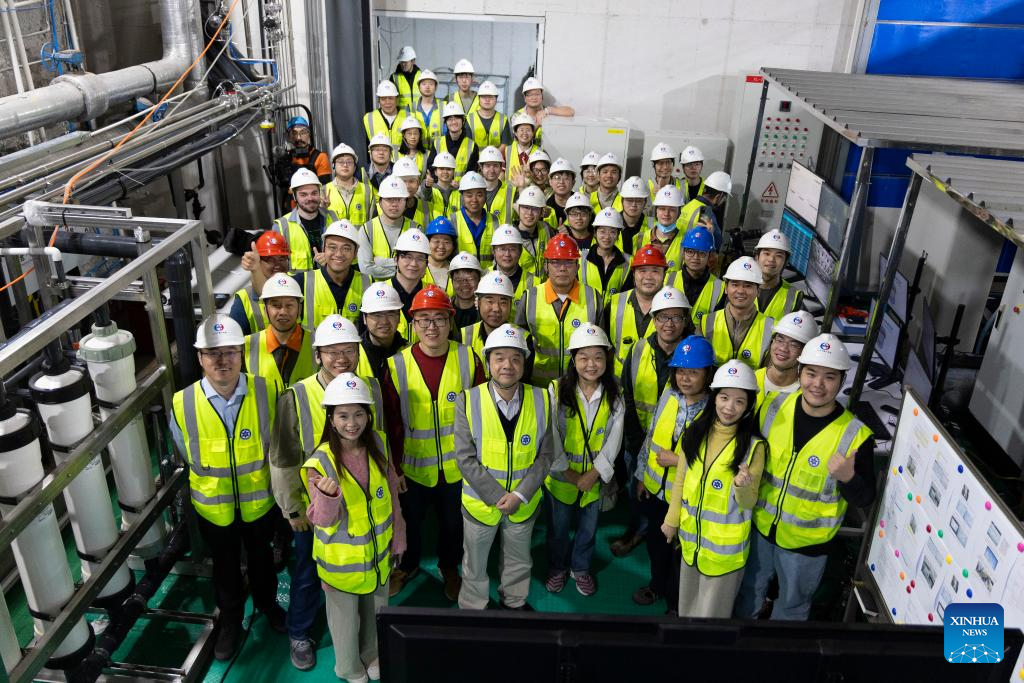
Researchers pose for a group photo to mark the start of liquid filling at the Jiangmen Underground Neutrino Observatory (JUNO) in Jiangmen, south China's Guangdong Province, Dec. 18, 2024.
The liquid filling of the central detector of JUNO started on Wednesday.
As one of the world's most powerful experiments to uncover neutrino mystery, JUNO is expected to operate for at least 30 years. (Xinhua/Jin Liwang)
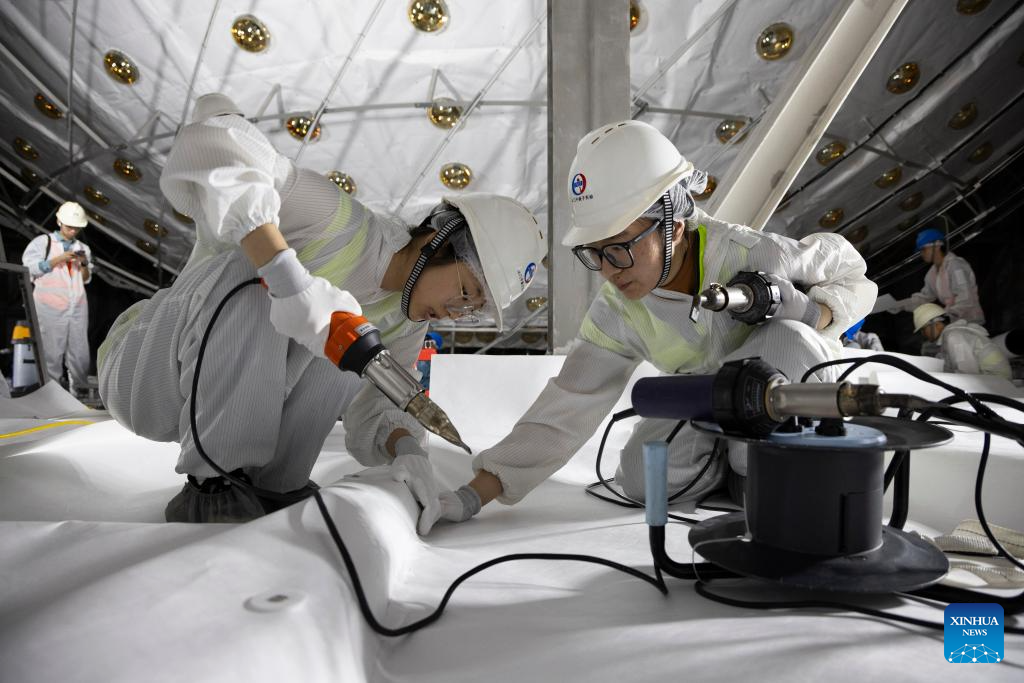
Staff members seal the bottom of a water tank with Tyvek material at the construction site of the Jiangmen Underground Neutrino Observatory (JUNO) in Jiangmen, south China's Guangdong Province, Dec. 16, 2024.
The liquid filling of the central detector of JUNO started on Wednesday.
As one of the world's most powerful experiments to uncover neutrino mystery, JUNO is expected to operate for at least 30 years. (Xinhua/Jin Liwang)
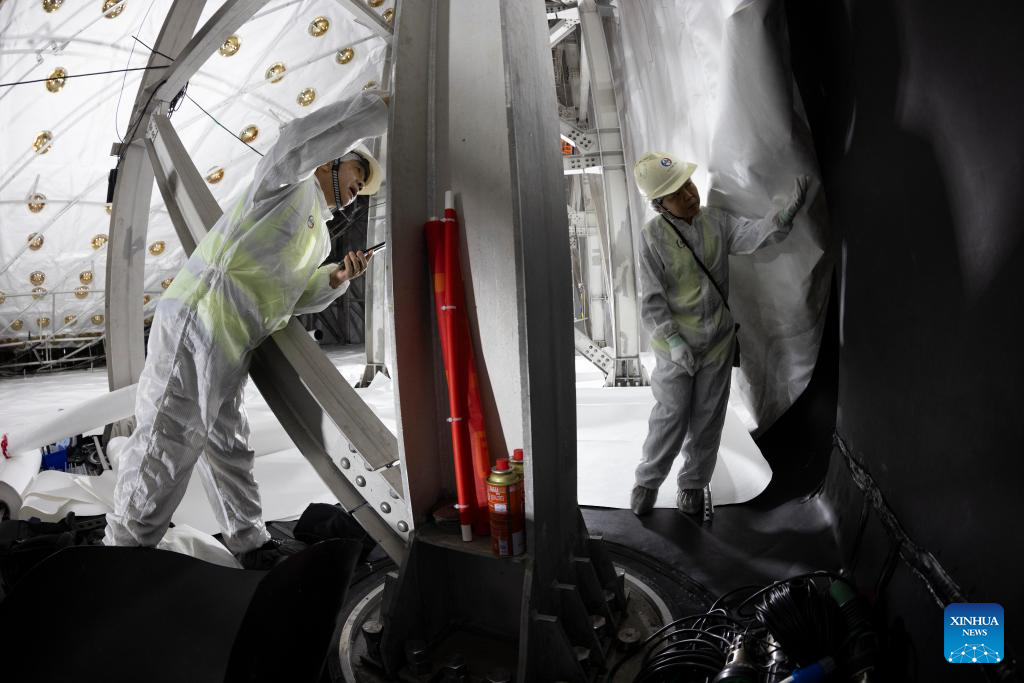
Wang Yifang (L), chief scientist of the Jiangmen Underground Neutrino Observatory (JUNO), and Ma Xiaoyan, chief engineer of the JUNO, inspect the construction site at the bottom of a water tank of JUNO in Jiangmen, south China's Guangdong Province, Dec. 16, 2024.
The liquid filling of the central detector of JUNO started on Wednesday.
As one of the world's most powerful experiments to uncover neutrino mystery, JUNO is expected to operate for at least 30 years. (Xinhua/Jin Liwang)
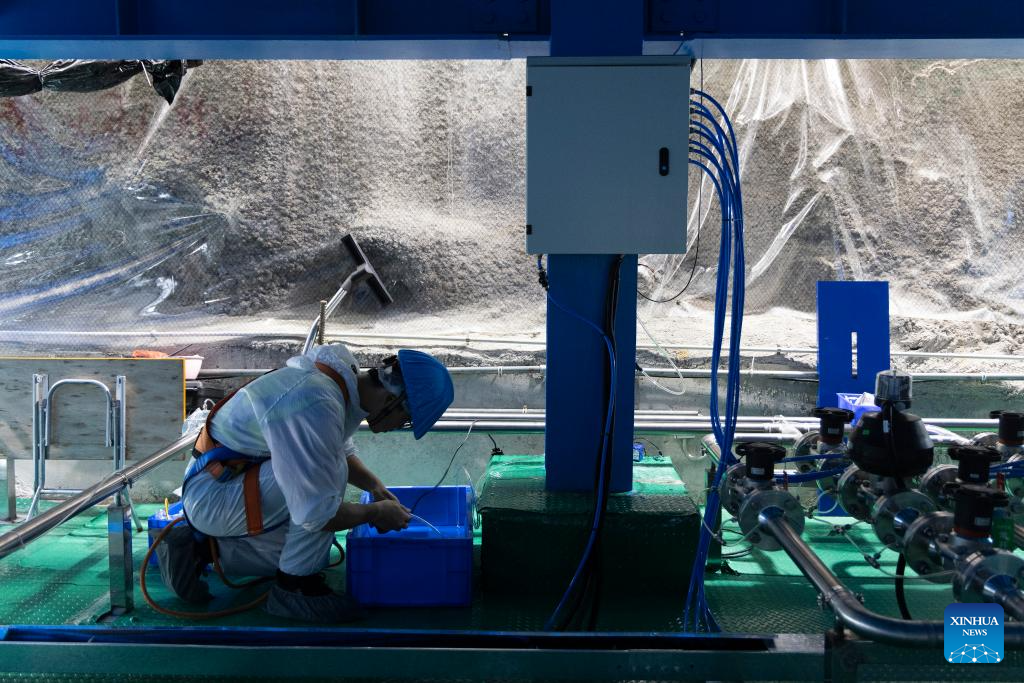
A researcher adjusts displacement sensors at the top of the central detector of the Jiangmen Underground Neutrino Observatory (JUNO) in Jiangmen, south China's Guangdong Province, Dec. 17, 2024.
The liquid filling of the central detector of JUNO started on Wednesday.
As one of the world's most powerful experiments to uncover neutrino mystery, JUNO is expected to operate for at least 30 years. (Xinhua/Jin Liwang)


Chinese Yue Opera reimagines classical tales in London for contemporary audiences

Tourism boosts local economy in Bamei Village, China's Yunnan

In pics: Wild populations of Milu deer reestablished in China after 40 years of conservation efforts

China's "Avatar" city Zhangjiajie rises as a global tourism magnet
点击右上角![]() 微信好友
微信好友
 朋友圈
朋友圈

请使用浏览器分享功能进行分享
